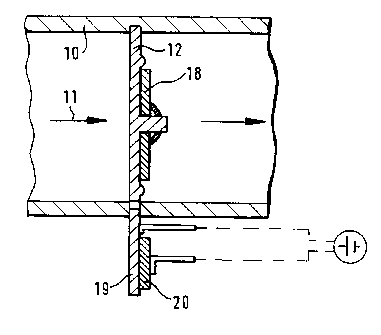Some of the information on this Web page has been provided by external sources. The Government of Canada is not responsible for the accuracy, reliability or currency of the information supplied by external sources. Users wishing to rely upon this information should consult directly with the source of the information. Content provided by external sources is not subject to official languages, privacy and accessibility requirements.
Any discrepancies in the text and image of the Claims and Abstract are due to differing posting times. Text of the Claims and Abstract are posted:
| (12) Patent: | (11) CA 2226875 |
|---|---|
| (54) English Title: | HEATING ARRANGEMENT |
| (54) French Title: | DISPOSITIF DE CHAUFFAGE |
| Status: | Term Expired - Post Grant Beyond Limit |
| (51) International Patent Classification (IPC): |
|
|---|---|
| (72) Inventors : |
|
| (73) Owners : |
|
| (71) Applicants : |
|
| (74) Agent: | NORTON ROSE FULBRIGHT CANADA LLP/S.E.N.C.R.L., S.R.L. |
| (74) Associate agent: | |
| (45) Issued: | 2007-01-09 |
| (86) PCT Filing Date: | 1996-05-11 |
| (87) Open to Public Inspection: | 1997-01-30 |
| Examination requested: | 2003-05-09 |
| Availability of licence: | N/A |
| Dedicated to the Public: | N/A |
| (25) Language of filing: | English |
| Patent Cooperation Treaty (PCT): | Yes |
|---|---|
| (86) PCT Filing Number: | PCT/EP1996/002033 |
| (87) International Publication Number: | EP1996002033 |
| (85) National Entry: | 1998-01-14 |
| (30) Application Priority Data: | ||||||
|---|---|---|---|---|---|---|
|
A heating arrangement, particularly for preventing freezing of pipes for
delivering crankcase gas from the crankcase of an internal combustion engine
to the
air intake, in which a valve (12, 18) is provided which includes at least one
metal
plate, and a PTC thermistor (20) or a resistance heater is disposed on the
metal
plate.
L'invention concerne un dispositif de chauffage, servant notamment à éviter le gel de conduites servant à acheminer des gaz du carter-moteur depuis le carter d'un moteur à combustion interne jusqu'à la zone d'admission. Une soupape (12,18) présente au moins une plaque métallique sur laquelle est disposée une résistance à coefficient de température positif (20) ou un élément de chauffage par effet Joule.
Note: Claims are shown in the official language in which they were submitted.
Note: Descriptions are shown in the official language in which they were submitted.

2024-08-01:As part of the Next Generation Patents (NGP) transition, the Canadian Patents Database (CPD) now contains a more detailed Event History, which replicates the Event Log of our new back-office solution.
Please note that "Inactive:" events refers to events no longer in use in our new back-office solution.
For a clearer understanding of the status of the application/patent presented on this page, the site Disclaimer , as well as the definitions for Patent , Event History , Maintenance Fee and Payment History should be consulted.
| Description | Date |
|---|---|
| Inactive: IPC deactivated | 2019-01-19 |
| Inactive: First IPC assigned | 2018-03-05 |
| Inactive: IPC removed | 2018-03-05 |
| Inactive: IPC removed | 2018-03-05 |
| Inactive: IPC assigned | 2018-03-05 |
| Inactive: Expired (new Act pat) | 2016-05-11 |
| Inactive: IPC expired | 2016-01-01 |
| Grant by Issuance | 2007-01-09 |
| Inactive: Cover page published | 2007-01-08 |
| Pre-grant | 2006-10-26 |
| Inactive: Final fee received | 2006-10-26 |
| Amendment After Allowance Requirements Determined Compliant | 2006-08-07 |
| Letter Sent | 2006-08-07 |
| Amendment After Allowance (AAA) Received | 2006-07-10 |
| Notice of Allowance is Issued | 2006-05-18 |
| Letter Sent | 2006-05-18 |
| Notice of Allowance is Issued | 2006-05-18 |
| Inactive: Approved for allowance (AFA) | 2006-05-08 |
| Amendment Received - Voluntary Amendment | 2006-04-11 |
| Inactive: IPC from MCD | 2006-03-12 |
| Inactive: IPC from MCD | 2006-03-12 |
| Inactive: S.30(2) Rules - Examiner requisition | 2005-10-11 |
| Letter Sent | 2003-06-09 |
| Request for Examination Received | 2003-05-09 |
| Request for Examination Requirements Determined Compliant | 2003-05-09 |
| All Requirements for Examination Determined Compliant | 2003-05-09 |
| Amendment Received - Voluntary Amendment | 2003-05-09 |
| Inactive: Single transfer | 1998-05-08 |
| Inactive: First IPC assigned | 1998-04-24 |
| Classification Modified | 1998-04-24 |
| Inactive: IPC assigned | 1998-04-24 |
| Inactive: IPC assigned | 1998-04-24 |
| Inactive: IPC assigned | 1998-04-21 |
| Inactive: Courtesy letter - Evidence | 1998-04-14 |
| Inactive: Notice - National entry - No RFE | 1998-04-07 |
| Application Received - PCT | 1998-04-06 |
| Amendment Received - Voluntary Amendment | 1998-01-14 |
| Application Published (Open to Public Inspection) | 1997-01-30 |
There is no abandonment history.
The last payment was received on 2006-05-01
Note : If the full payment has not been received on or before the date indicated, a further fee may be required which may be one of the following
Patent fees are adjusted on the 1st of January every year. The amounts above are the current amounts if received by December 31 of the current year.
Please refer to the CIPO
Patent Fees
web page to see all current fee amounts.
Note: Records showing the ownership history in alphabetical order.
| Current Owners on Record |
|---|
| FILTERWERK MANN & HUMMEL GMBH |
| Past Owners on Record |
|---|
| HANS-WERNER HOLCH |
| HEINZ MUELLER |
| THOMAS BUTZ |